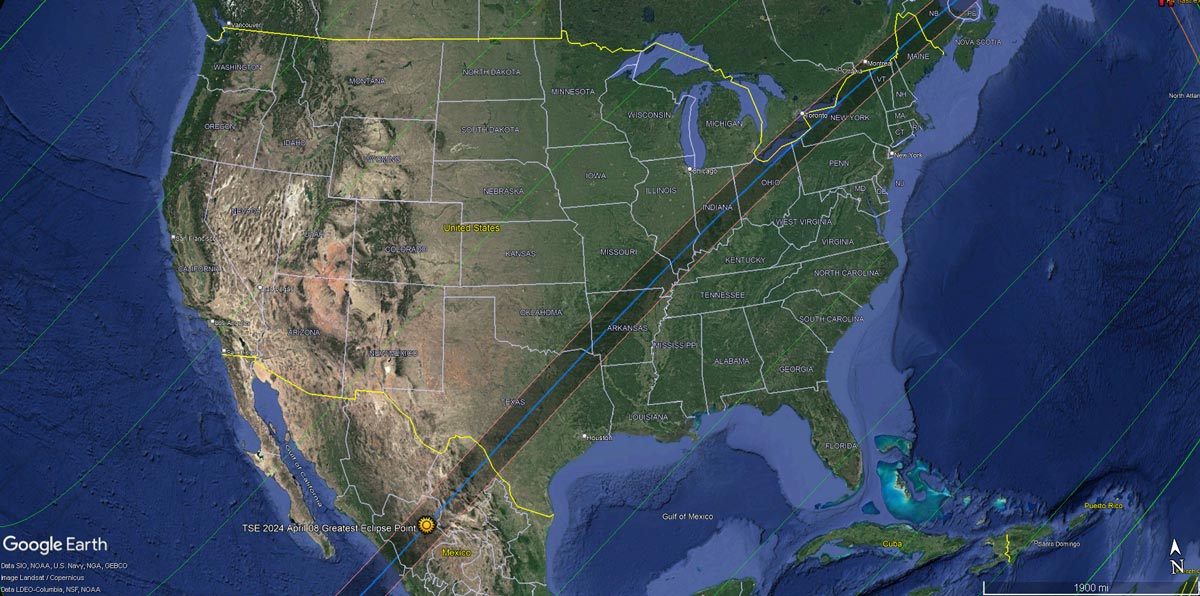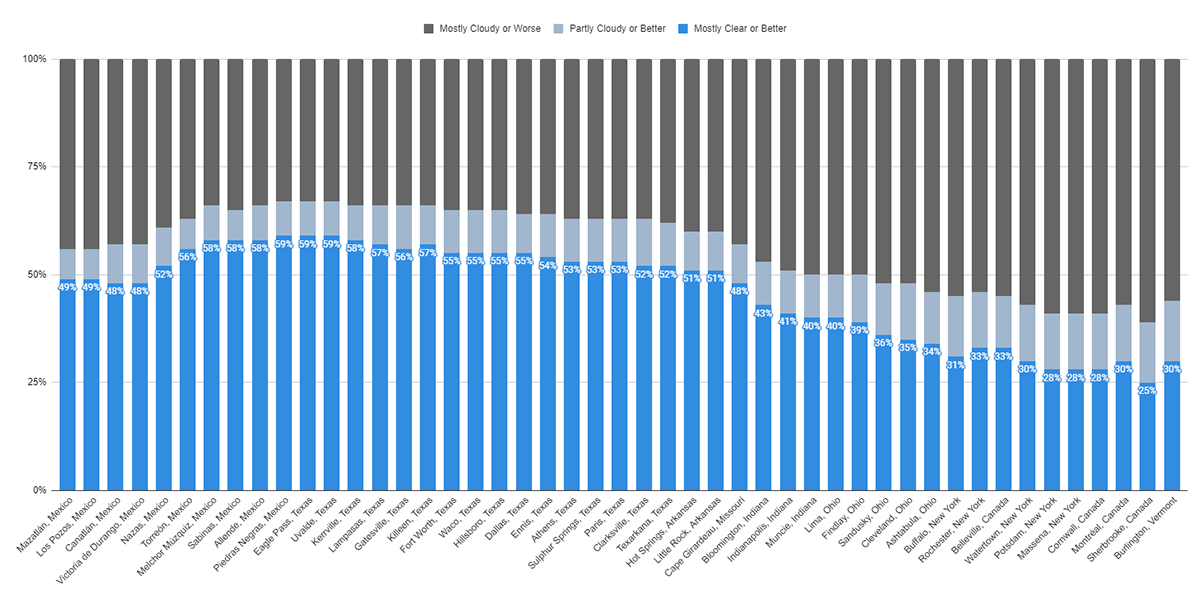Best Places to See the 2024 American Eclipse Based on Historical Weather Data
Successful observations of Total Solar Eclipses often requires planning months or years ahead and traveling long distances to reach locations that will offer the longest totality duration and the highest chances of clear skies on the day of the eclipse.
The Total Solar Eclipse of April 8, 2024 is no exception to this. The eclipse will be visible inside strip of land approximately 190 kilometers wide, starting from the western coast of Mexico and ending in Maine, Nova Scotia and Newfoundland Island.

A large amount of historical weather data is available and can be used to get insights about the typical weather conditions on the day and time of the eclipse (April 8, in this case) at different locations inside the totality strip. These insights can help identify the areas that have, on average, the lowest cloud coverage and so could offer the best chances of a successful observation.
The table below shows the results of such an analysis, using weather data provided by MERRA-2 and summarized by Weather Spark. For a list of locations inside the totality strip, the table below provides the following data:
- Totality duration
- Probability of having "Mostly Clear" weather conditions, or better (ideal conditions for the observation)
- Probability of having "Partly Cloudy" weather conditions, or better (potentially good conditions, but not free of risks of not seeing some phases of the eclipse)
- Probability of having "Mostly Cloudy" weather conditions or worse (significant risk of missing some part of the eclipse)
where the definitions are as follows:
- Clear: less than 1/8 of the sky is covered by with opaque (not transparent) clouds
- Mostly Clear: 1/8th to 2/8ths of the sky is covered by with opaque (not transparent) clouds
- Partly Cloudy: between 3/8 and 5/8 of the sky is covered by clouds
- Mostly Cloudy: 6/8 or more of the sky is covered by clouds
| Country | State | Place | Totality Duration | Mostly Clear or Better | Partly Cloudy or Better | Mostly Cloudy or Worse | Link to Weather |
| Mexico | Sinaloa | Mazatlán | 4m 22s | 49% | 56% | 44% | Weather |
| Mexico | Sinaloa | Los Pozos | 4m 26s | 49% | 56% | 44% | Weather |
| Mexico | Durango | Canatlán | 4m 29s | 48% | 57% | 43% | Weather |
| Mexico | Durango | Victoria de Durango | 3m 48s | 48% | 57% | 43% | Weather |
| Mexico | Durango | Nazas | 4m 29s | 52% | 61% | 39% | Weather |
| Mexico | Coahuila | Torreón | 4m 14s | 56% | 63% | 37% | Weather |
| Mexico | Guadalajara | Melchor Múzquiz | 4m 29s | 58% | 66% | 34% | Weather |
| Mexico | Coahuila | Sabinas | 4m 13s | 58% | 65% | 35% | Weather |
| Mexico | Guadalajara | Allende | 4m 24s | 58% | 66% | 34% | Weather |
| Mexico | Guadalajara | Piedras Negras | 4m 26s | 59% | 67% | 33% | Weather |
| US | Texas | Eagle Pass | 4m 26s | 59% | 67% | 33% | Weather |
| US | Texas | Uvalde | 4m 16s | 59% | 67% | 33% | Weather |
| US | Texas | Kerrville | 4m 26s | 58% | 66% | 34% | Weather |
| US | Texas | Fredericksburg | 4m 26s | 58% | 66% | 34% | Weather |
| US | Texas | Lampasas | 4m 26s | 57% | 66% | 34% | Weather |
| US | Texas | Gatesville | 4m 24s | 56% | 66% | 34% | Weather |
| US | Texas | Killeen | 4m 17s | 57% | 66% | 34% | Weather |
| US | Texas | Fort Worth | 2m 46s | 55% | 65% | 35% | Weather |
| US | Texas | Waco | 4m 13s | 55% | 65% | 35% | Weather |
| US | Texas | Hillsboro | 4m 24s | 55% | 65% | 35% | Weather |
| US | Texas | Dallas | 3m 53s | 55% | 64% | 36% | Weather |
| US | Texas | Ennis | 4m 24s | 54% | 64% | 36% | Weather |
| US | Texas | Athens | 3m 23s | 53% | 63% | 37% | Weather |
| US | Texas | Sulphur Springs | 4m 23s | 53% | 63% | 37% | Weather |
| US | Texas | Paris | 4m 04s | 53% | 63% | 37% | Weather |
| US | Texas | Clarksville | 4m 23s | 52% | 63% | 37% | Weather |
| US | Texas | Texarkana | 2m 27s | 52% | 62% | 38% | Weather |
| US | Arkansas | Hot Springs | 3m 37s | 51% | 60% | 40% | Weather |
| US | Arkansas | Little Rock | 2m 30s | 51% | 60% | 40% | Weather |
| US | Missouri | Cape Girardeau | 4m 07s | 48% | 57% | 43% | Weather |
| US | Indiana | Bloomington | 4m 04s | 43% | 53% | 47% | Weather |
| US | Indiana | Indianapolis | 3m 51s | 41% | 51% | 49% | Weather |
| US | Indiana | Muncie | 3m 48s | 40% | 50% | 50% | Weather |
| US | Ohio | Lima | 3m 53s | 40% | 50% | 50% | Weather |
| US | Ohio | Findlay | 3m 45s | 39% | 50% | 50% | Weather |
| US | Ohio | Sandusky | 3m 48s | 36% | 48% | 52% | Weather |
| US | Ohio | Cleveland | 3m 52s | 35% | 48% | 52% | Weather |
| US | Ohio | Ashtabula | 3m 48s | 34% | 46% | 54% | Weather |
| US | New York | Niagara Falls | 3m 33s | 31% | 44% | 56% | Weather |
| US | New York | Buffalo | 3m 48s | 31% | 45% | 55% | Weather |
| US | New York | Rochester | 3m 39s | 33% | 46% | 54% | Weather |
| Canada | Ontario | Belleville | 2m 04s | 33% | 45% | 55% | Weather |
| US | New York | Watertown | 3m 42s | 30% | 43% | 57% | Weather |
| US | New York | Potsdam | 3m 14s | 28% | 41% | 59% | Weather |
| US | New York | Massena | 2m 30s | 28% | 41% | 59% | Weather |
| Canada | Ontario | Cornwall | 2m 18s | 28% | 41% | 59% | Weather |
| Canada | Quebec | Montréal | 1m 22s | 30% | 43% | 57% | Weather |
| Canada | Quebec | Sherbrooke | 3m 27s | 25% | 39% | 61% | Weather |
| US | Vermont | Burlington | 3m 16s | 30% | 44% | 56% | Weather |
| Canada | New Brunswick | Miramichi | 3m 09s | 27% | 40% | 60% | Weather |
| Canada | Newfoundland | Stephenville | 2m 07s | 27% | 40% | 60% | Weather |
The following chart shows the probability of clear skies for the locations listed in the table above, following the totality strip from west to east:

Conclusions
Based on historical weather and cloud coverage data, the best locations to go and see the April 8, 2024 Solar Eclipses are inside the totality strip close to the Mexico/Texas border, both on the Mexican and US side. These locations in particular seem to be the most promising in absolute:
- Melchor Múzquiz, Mexico
- Allende, Mexico
- Piedras Negras, Mexico
- Eagle Pass, Texas
- Kerrville, Texas
- Fredericksburg, Texas
- Lampasas, Texas
From these locations it will be possible to observe the eclipse with the longest totality duration (more than 4 minutes and 20 seconds) and with the highest probability of mostly clear skies (58/59% chances of mostly clear skies on the day of the eclipse). Many other locations in Mexico and Texas will in any case provide good chances of observing the eclipse, with a probability greater than 50% of having mostly clear skies.

